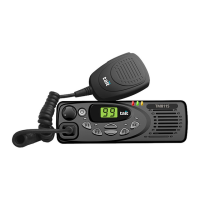TM8100/TM8200 Service Manual Circuit Descriptions 75
© Tait Electronics Limited June 2006
Active Loop Filter The loop filter continuously integrates the current pulses from the charge
pump and produces a steady DC output voltage that tunes the VCO
(or VCOs). When the VCO frequency is correct, there is no frequency
error and therefore no charge-pump output, and so the loop filter’s output
voltage remains constant. If the frequency is too high or too low, the error
will result in the output of charge-pump current pulses (negative or positive
depending on the sign of the error). The loop filter’s output voltage will
change accordingly, causing the VCO frequency to change in proportion.
The synthesizer design is such that normally the VCO frequency will be
automatically corrected.
Re-tuning of VCO
Frequency
When the radio changes channels or switches between receive and transmit,
the VCO frequency must be changed. The rate at which the VCO is re-
tuned is dependent on many factors, of which the loop filter is the main
factor. The loop filter is an integrator built around an operational amplifier.
The resistors and capacitors of the filter affect both the switching time and
the stability of the synthesizer; the values of these components have been
carefully selected to give optimum control characteristics.
Speed-up
Tech ni que s
To reduce the change-over time between transmit and receive, part-time
speed-up techniques have been implemented. Speed-up involves changing
some resistor values while simultaneously changing the PLL IC settings.
This process is implemented in hardware under software control in
conjunction with use of the synthesized reference input. The result is a
transmit-receive settling time of less than 4.5ms. (The switching time is
measured for a frequency change equal to the first IF plus 10MHz or 1MHz,
depending on the repeater offsets used for the band. This implies a
synthesizer transmit-receive change-over plus an offset of 1MHz or 10MHz
in less than 4.5ms. The ramp-up and ramp-down of the transmitter, which
totals 1ms, extends this change-over time to 5.5ms.)

